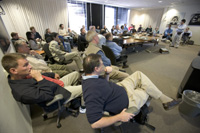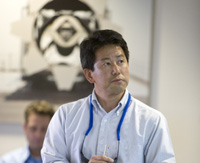
Every chair was filled at the closing talks of the SMTF meeting last Friday |
Focusing mainly on technical issues related to the International Linear Collider linac, the SMTF (Superconducting Module &Test Facility) Collaboration met at Fermilab on 5-7 October. Members from KEK, DESY, Italy, Daresbury in the UK and several U.S. institutions and universities divided into working groups. A number of scientists from around the globe also participated virtually via videoconference connections and streaming video.
"With members from Fermilab, SLAC, JLab, Argonne, LBNL, MSU, LANL, NIU, Penn and Cornell, U.S. collaboration was very strong at the meeting", said Cornell University physicist Hasan Padamsee, chair of the SMTF technical board. Established in early 2004, a group of U.S. labs and institutions interested in superconducting radiofrequency technology created the SMTF collaboration to work on such projects as the ILC FEL and ERL light sources. The ILC became a top priority for the collaboration after the ITRP decision in August 2004. “The goal for this meeting was to address two of the major technical issues for the ILC linac – reproducibility in cavity performance and a cryomodule design best suited for ILC", Padamsee said. "We were very productive."
With the recent achievement of a gradient of 52 MV/m –- a world record -- for a single-cell re-entrant shape cavity at KEK, R&D results demonstrate that high numbers can be achieved using superconducting technology. SMTF members in Working Group 1 discussed the reproducibility of these results, particularly in 9-cell cavities. "The 9-cell structure performs at 35 MV/m, but the spread is broad", said Padamsee. "What are the factors for this large a spread? What needs to be done to identify the performance factors? There are lots of discussions with the labs that produce the cavities right now to try to answer these questions." Such working group leaders as John Mammosser of JLAB, Christian Boffo of Fermilab and Tsuyoshi Tajima of LANL led detailed discussions on electropolishing, high pressure rinse purity issues and materials.

Tsuyoshi Tajima of LANL presents at the closing talks of the SMTF meeting |
Working Group 2 addressed ILC cryomodule design. Now in a third generation of design, Padamsee explained that cryomodules have improved greatly over time. "If we want to make 1000 cryomodules for the ILC, we have to continue to make evolutionary changes", he said. “This group discussed the changes that need to be made before we launch the prototype and identified the tasks that we need to take us to the next step." Working Group 2 leaders, including John Weisend of SLAC, Rolf Lange of DESY and Norihito Ohuchi of KEK, led the discussions about cryomodule design.
Many SMTF members also participate in the TESLA Technology Collaboration (TTC) at DESY. In addition to discussing technical applications, participants also addressed the role of the SMTF collaboration in the future, and if the two groups should merge. The conclusion is yet to come, explained Padamsee. "There are several paths for evolution to incorporate SMTF into the larger framework in the GDE," he said. "We are talking about how to do things that are common, and we need to work out how to make things more efficient."
All of the activities that took place at this meeting will continue at the TTC meeting in December in Frascati. More information about the SMTF meeting and talks are available online.
|


